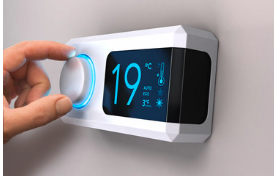What Is Heating?
Heating is the process of raising the temperature of an object or a space. Heat energy can be transferred between objects through conduction, convection, and radiation. Your gas furnace uses natural gas to combust fuel, creating heat energy. A blower fan moves that warm air through a supply-air plenum and into your home’s air duct system. Click here at https://comfortprosheatandair.com/ to learn more about heating.
A radiator is a heat exchanger that transfers thermal energy from hot coolant to cooled air. The main function of the radiator is to prevent the engine from overheating and is used in multiple types of engines, including automobiles, piston aircraft engines, locomotives, stationary generators, and motorcycles.
The radiator is located in the front of the vehicle and consists of a large metal block with a series of thin metal cooling fins that vent the air. The radiator core is the central area of the radiator where the hot coolant releases its heat and gets cooled before going back into the cooling system for another round of heat exchange.
After passing through the engine, the coolant is pumped into the radiator by a water pump. Once the coolant arrives at the radiator, it enters the inlet port and flows through a series of parallel tubes that are connected to the cooling fins. The fins create a large surface area to transfer heat and help the coolant to flow faster through the radiator. As the coolant flows through the tubes, a fan blows cool air across the fins to lower their temperature and draw heat away from the liquid, cooling it down before returning it to the engine.
Because a radiator is filled with such an intensely hot liquid, it needs to be able to withstand high temperatures without boiling over. To achieve this, the radiator is designed with a core that has a large surface area that can hold heat for extended periods and a series of fins to draw heat from the engine and cool the liquid more quickly.
Once the fluid is cooled, it exits the radiator through the outlet port and back into the engine where it begins its next cycle of heat exchange. The temperature of the engine is regulated by the thermostat and the coolant is continually circulating to maintain an optimal operating temperature.
Radiators are usually made of aluminum and plastic, but some manufacturers use innovative materials such as Kevlar to increase strength and durability. Radiators are also prone to cracking and leaking over time, which is why it’s important to keep up with regular fluid changes to avoid the risk of overheating. Common radiator leak signs include caked-up, crusty coolant, or puddles of green liquid under the car.
Core
A core is the center, innermost part, or essence of something, such as the seed-containing middle of an apple, or a group of close friends. It can also refer to a person’s heart, as in “heartfelt” or “to the core.” The word was first recorded in the late 14th century.
The Earth’s core is a hot, dense ball of iron-nickel alloy (Fe and Ni). The heat that keeps the outer core liquid comes from radioactive decay, leftover energy from the planetary formation, and the slipping of tectonic plates over the mantle.
Geoscientists can’t directly study the core, but they know its temperature and pressure from seismic waves, which travel through the solid layers of rock in the Earth. They’ve also studied the behavior of these waves in different rock types, using computer models to simulate their behavior under varying conditions. These studies reveal that a sudden “shadow zone” deep in the Earth, where a type of body wave called an s-wave stopped or was altered, indicates the existence of a liquid inner core.
Pressure Cap
The pressure cap keeps the radiator system pressurized. If this cap malfunctions, a burst of pressure will occur damage the radiator’s hoses, and strain the radiator seams. A pressure cap has a large valve with a spring inside and a smaller vacuum valve. A shoulder in the radiator filler neck provides a seat for the cap’s lower seal and a gasket on this seat prevents leakage between the cap and the neck. When the cap is pressed on, its pressure spring compresses against the vacuum valve, and pressurized coolant flows through the lower valve into the radiator overflow tank. This valve also keeps air from escaping the cooling system. The pressure cap allows the coolant to expand when it gets hot and also contracts when it cools down, which is important for good flow of the fluid.
Pressure raises the boiling point of a liquid, which means that it stays a liquid longer and does not transform into a vapor, as it would without pressure. This gives the engine more heat exchange efficiency and keeps it from overheating when it operates at higher temperatures.
Some racers use high-pressure caps that can reach 15 psi or more to get an extra edge on the track. However, this can create problems for the cooling system because the cap may not be rated for that level of pressure. This can cause the hoses and even the radiator to strain and rupture.
A high-pressure cap can also cause the coolant to boil and lose its heat-transferring properties. It’s best to stick with a stock cap that has the proper pressure rating for your vehicle.
Components
Heating elements convert electrical energy into thermal energy through a physical process known as Joule heating. They are made from ribbon coils or strips of wire that have a high enough level of resistance to produce heat when an electric current passes through them. The resistance is determined by the material of the element and its chemical composition. Some common heater materials include nickel-chromium alloy, iron-chromium-aluminum alloy, molybdenum disilicide, silicon carbide, and graphite. The oxidation resistance, low-temperature coefficient of resistance, toughness, and melting point are important characteristics to consider when choosing an appropriate material for a specific application.
To function, a heating element must have sufficient electrical resistivity and good oxidation resistance. In addition, it must be able to sustain a high temperature without damaging itself or breaking down. Most heaters have a certain level of oxidation that eventually limits their life and performance. A variable voltage supply is usually used to maintain the desired power output of the element by gradually increasing the power to it over time.
The design of heating elements varies significantly depending on the application and material type. The choice of material and its characteristics also determine the efficiency, maximum temperature, and durability of a heating element for different applications.
Some types of heating elements are self-regulating, meaning that each point on the element maintains a constant temperature without the need for additional regulating electronics. For example, PTC (positive temperature coefficient) heaters have a structure that increases its resistivity exponentially with increasing temperatures. This feature allows the element to prevent itself from overheating and requires additional safety mechanisms like overheating protection.
Another type of self-regulating heating element is etched foil heaters. These are printed on a variety of substrates such as metal, ceramic, glass, and polymer using metal or alloy thick film pastes. They offer the same functionality as traditional metal-sheathed resistance wire heaters with a smaller form factor and better temperature uniformity.
Dirty Drain Lines
Your air conditioner’s drain line is the primary conduit that routes condensation away from your home’s outdoor condenser unit and discharges it to a safe location. If the line becomes clogged, it will overflow and can cause water damage.
To avoid this, the line should be cleaned and inspected regularly. During routine maintenance, a professional should also clear away any root growth that could be causing the line to become blocked.
The first step is to locate the drain line’s exit point. Trace the PVC pipe as it runs through your home until you find where it exits. It should be near your air conditioning unit and may terminate over a window well, basement floor drain, or another visible location. You should be able to access the outdoor and indoor sections of the line with a wet/dry vacuum hose attachment.
Look for the drain line’s cap, which is usually a screw-off or pull-off type of plug. If the cap is missing, remove it and visually inspect the line for blockages. It should have a P trap at the end, which helps to prevent odors from coming into your home.
The most common causes of a clogged drain line are fats, oils, and grease (FOG), which are liquid when poured down the drain but quickly firm up and cause a clog. Foreign objects, such as sanitary products, baby wipes, paper towels, facial tissues, so-called flushable wipes, extra-thick toilet paper, and other bulky items can also build up and clog your sewer lines.
If you see that your water is backing up into showers and tubs, or that sewage is flowing out of your toilets, it’s probably a sign that your sewer line has become clogged. If this is the case, you’ll need to call a plumber for emergency sewer repair services.
Fortunately, it’s fairly easy to clean the AC drain line and avoid a costly clog that can lead to water damage in your home. By pouring a cup of white vinegar into the line once a month, you’ll eliminate mold, mildew, and bacteria that can build up and clog the line.
